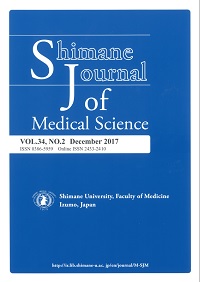Shimane University Faculty of Medicine
ISSN :0386-5959(in print)
ISSN :2433-2410(online)


These article are licensed under a Creative Commons Attribution-NonCommercial-NoDerivatives 4.0 International License.
number of downloads : ?
Use this link to cite this item : https://ir.lib.shimane-u.ac.jp/7583
Shimane Journal of Medical Science 28 1
2011-12-01 発行
A Case of Acute Basilar Artery Occlusion for Which an Early Diagnosis Was Obtained by Flow-sensitive Alternating Inversion Recovery Magnetic Resonance Imaging
File
Description
Acute basilar artery occlusion(BAO)has a diagnosis difficulty and a poor prognosis. We report the use of tissue plasminogen activator intravenous therapy for BAO within 30 minutes of the initial symptoms, in a patient who underwent flow-sensitive alternating inversion recovery(FAIR)-MR imaging.
The presence of an ischemic penumbra is an important indicator of potentially better clinical outcome and fewer hemorrhagic complications resulting from thrombolysis therapy. This information can be obtained by comparison between the diffusion image and perfusion image of FAIR. An 85-year-old woman with chronic subdural hematoma underwent burr-hole surgery, and postoperatively the residual subdural fluid collection was well controlled. Three weeks later, she suddenly developed basilar artery thromboembolism and received t-PA intravenous therapy. Her modified NIH stroke scale score recovered from 20 to 7 without hemorrhagic complications.
We believe that FAIR-MR could become a valuable tool for taking thrombolysis therapy in patients with acute cerebral infarction.
The presence of an ischemic penumbra is an important indicator of potentially better clinical outcome and fewer hemorrhagic complications resulting from thrombolysis therapy. This information can be obtained by comparison between the diffusion image and perfusion image of FAIR. An 85-year-old woman with chronic subdural hematoma underwent burr-hole surgery, and postoperatively the residual subdural fluid collection was well controlled. Three weeks later, she suddenly developed basilar artery thromboembolism and received t-PA intravenous therapy. Her modified NIH stroke scale score recovered from 20 to 7 without hemorrhagic complications.
We believe that FAIR-MR could become a valuable tool for taking thrombolysis therapy in patients with acute cerebral infarction.
About This Article
Other Article
Is it Possible to Predict the Onset of Side Effects in Patients Treated with Subcutaneous Buserelin?
PP. 21 - 26
PP. 27 - 34
